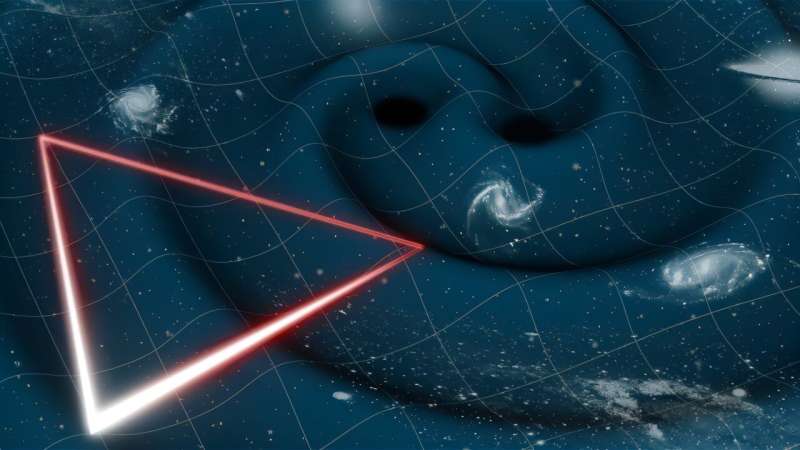
December 17, 2024 by David Appell , Phys.org
Collected at: https://phys.org/news/2024-12-gravitational-memory-effect-core-collapse.html
Einstein’s theory of gravity, general relativity, has passed all tests with predictions that are spot-on. One prediction that remains is “gravitational wave memory”—the prediction that a passing gravitational wave will permanently change the distance between cosmic objects.
Supernovae—collapsing stars that explode outward—are thought to be generators of gravitational waves, though none have yet been definitively detected by the gravitational wave interferometers on Earth. Nor has the gravitational wave memory effect been seen, from mergers or supernovae, due to the limited sensitivity of interferometers below wave frequencies of 10 hertz.
But now a new study presents an approach to detecting the effect using currently existing gravitational wave observatories. The paper is published in Physical Review Letters.
To-date, all the gravitational waves that have been detected originated from black hole-black hole mergers, neutron star-neutron star mergers, or mergers of one of each. But collapsing supernovae of mass greater than about 10 solar masses are expected to emit gravitational waves as well, though of lower wave amplitude and with a different signature in a gravitational wave interferometer.
In such supernovae, called “core-collapsing supernovae” (CCSN), the core of a massive star undergoes sudden collapse when the energy generated from its fusion energy can no longer counteract the star’s own gravity.
This results in an outgoing shock wave from the implosion. Some of the outward energy will be in the form of gravitational waves due to the star’s changing quadrupole moment—with total energy of about 1040 joules—unless the star’s matter is spewed isotropically. (Unlike electromagnetic waves, gravitational waves have no dipole moment due to conservation of momentum.)
Emitted as well are visible light and neutrinos, opening up the possibility of a multi-messenger detection when they arrive at Earth.
CCSN gravitational waves would be especially useful because electromagnetic signals from the supernova come from its edge, while gravitational waves are generated deep in its interior and so contain information not otherwise available.
However, gravitational waves from CCSN have a smaller amplitude than those from black hole-black hole mergers, with a strain one to two orders of magnitude less (the strain depends inversely on the distance of the source from Earth). Their frequencies are generally lower, their duration is shorter, and the signal is more complex and less distinct than from massive two-body mergers.
However, at lower frequency gravitational waves from CCSN, approximately less than 10 hertz, the waves have a gravitational “memory” component due to anisotropic matter motion and aspherical emission of neutrinos. If the neutrino burst from the CCSN is not isotropic, it will generate additional gravitational radiation from that of the collapse.
Sourced by previously emitted waves, these “bursts with memory” waves are a different class of gravitational radiation where the gravitational disturbance at any point rises from zero, oscillates for a few cycles, and then, instead of dropping back to zero, settles down into a non-zero final value.
The gravitational wave memory effect has never been detected. High-frequency detectors like advanced LIGO are mostly insensitive to the memory effect because these detectors’ response time is generally much shorter than the characteristic time for the non-oscillatory part of the gravitational wave signal to build up to its final value.
Larger interferometers like the proposed space-based Laser Interferometer Space Antenna (LISA) are better because they have better sensitivity in the lower frequency bands where typical memory sources are stronger. (Lower frequency means higher wavelength, so detection requires interferometer arms of longer length.)
Colter J Richardson from the University of Tennessee, with CCSN modeling and data analysis colleagues from the U.S., Sweden and Poland, studied the memory effect using three state-of-the-art, three-dimensional simulations of non-rotating CCSNs with masses up to 25 solar masses, using a model called CHIMERA.
Their lowest mass of 9.6 solar masses is representative of lower mass CCSNs; the gravitational wave signals from their models all showed the “slow ramp-up to a nonzero strain value that is characteristic of the memory,” they wrote.
The gravitational wave signals from the CCSN explosions were largely random, but they found the ramp-up (of the wave amplitudes) and the memory phases exhibited “a high degree of regularity” that could be well approximated by logistic functions typical of studies of population growth.
They found that the gravitational wave signals from the CCSNs persisted for over a second. (By contrast, the first gravitational wave signal in 2015 lasted only 0.2 seconds.) They applied filters to the signals to remove noise, which reduced the ramp-up to the peak signal but did not erase it.
After further refinement, they applied matched filtering to the final signal, which is also used at current gravitational wave detectors—searching through a large number of previously calculated template waveforms to find any that are highly correlated with the refined detector signal. They found their model’s results for a 25 solar mass CCSN can be detected at 10 kiloparsecs (about 30,000 light-years) with a false alarm probability less than 0.05%—and within the range of current gravitational wave interferometers.
“Current efforts around the world for the detection of core-collapse supernova gravitational waves are substantial,” said Richardson. “Besides offering another detection strategy, we hope this letter motivates new investigations into the low-frequency region of gravitational wave astronomy.”
He noted that several paths exist for future research, “from the application of our methodology to the more common merger events, to investigating how the next generation of detectors will be sensitive to the memory.”
More information: Colter J. Richardson et al, Detecting Gravitational Wave Memory in the Next Galactic Core-Collapse Supernova, Physical Review Letters (2024). DOI: 10.1103/PhysRevLett.133.231401. On arXiv: DOI: 10.48550/arxiv.2404.02131
Journal information: Physical Review Letters , arXiv

Leave a Reply